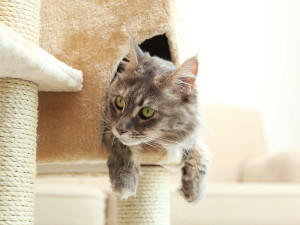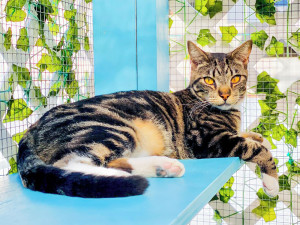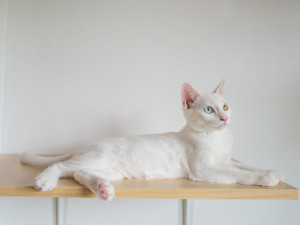Why Cats Like to Hit the High Spots
Animal behaviorist Karen B. London on how to create great escapes for your cat without leaving home.
If we could ask cats what they want in the way of home furnishings, they would nearly all mention places to perch up high. Cats almost universally love to have elevated options, so if you want your home to be a cat paradise, consider decorating with an eye for making use of vertical space.
Vertical perches are important for many reasons, and you may not always know which benefit means the most to each particular cat. Elevated areas offer cats the opportunity to escape from anyone who is upsetting them. That most frequently means dogs and children, but can also apply to adults, especially unfamiliar ones. Escaping vertically is the first choice for many cats if they have the option, and some cats who hide under the bed or in a closet would spend more time in the rooms where the rest of the family congregate if elevated escapes were present. Being out of reach of dogs and humans allows many cats to feel safer and more comfortable in their own home.
Save on the litter with color-changing tech that helps you better care for your cat.
By choosing to be up high even before something (or someone!) causes them distress rather than just using them as an escape, cats can avoid being surprised or ambushed by other cats, by chasing dogs or by the visitor who just loves to scoop up cats, no matter how unwillingly the cat tolerates being held. They can see anyone coming with greater warning time, making the vantage point provided by height invaluable to your favorite feline. The opportunity to keep a lookout may relate to their predatory nature as it is natural for many species of cats to go to a raised area to watch for prey. It may also reflect cats’ need to be on the lookout to avoid being taken by predators themselves.
Sleeping in an elevated spot is popular among cats, especially if the perch offers them protective edges to support their back. Having a high spot with its own little wall or next to an actual wall seems to make many cats feel less vulnerable, making those spots a top choice, so to speak.
How much do you spend on your pet per year?
Some of the best high perches are cat trees (also called kitty condos or cat stands) designed specifically for cats, though the fridge, a bookcase, a window perch, cat hammock, or the top of the cabinets also make great vertical escapes. Cat trees with many components also provides opportunities for play, physical exercise, and mental exercise, all of which enhance the lives of our feline family members.
To allow cats the full range of benefits offered by the elevated perches they adore, it’s wise to have a high option in every room. Vertical escapes throughout the house help cats feel safe and secure because they can jump up onto one when they feel the need no matter where they are. Many cats are drawn to the extra warmth provided by height, especially if they can sun in those areas, so place at least one high cat perch in a sunny spot if possible. The sunny perches are frequently favorite ones, and they are often chosen for cat naps or relaxation in any form.
An appealing feature of high perches for some cats is those spots have only their scent on them. Due to their inaccessibility to everyone else in the household, no scents from other family members such as dogs or people are present. Scenting perches with cat pheromone (Feliway) can enhance the feelings of comfort and lessen the anxiety of many cats. Research has shown that cats prefer elevated vantage points, and it’s always wise to follow the science.







